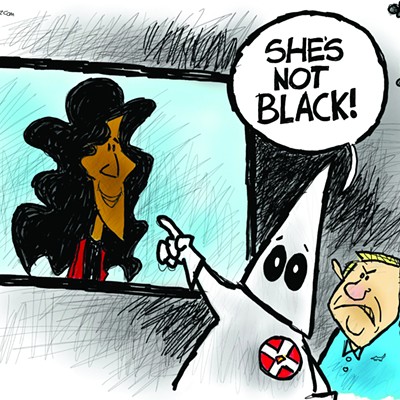We have a long tradition of the person or team with the most points, runs or votes winning--except when it comes to electing our president, the highest office in the land. How do we explain that to young people, already so disengaged from politics?
It's like two elections taking place, side by side, one open and the other hidden. And suddenly the nation is realizing that the one that counts is the hidden one. Nothing less than the legitimacy of the presidency is hanging in the balance.
The blame for this democratic anomaly rests with that 18th-century anachronism, the Electoral College. Created in less democratic times by our Founders, the Electoral College is a clumsy device that has been the subject of more proposed amendments than any other part of our constitution. It harkens back to a time when the U.S. Senate also was devised to be elected by our state legislatures, instead of a direct vote of the people. We changed the Senate to a direct vote in 1913 with the 17th amendment. But we are still left with the ponderous Electoral College.
Here's how it works. Each of the 50 states' presidential races is conducted as an individual contest, with its votes weighted to its population. The presidential winner does not need to win a majority of the national popular vote--just more votes than other candidates in any piecemeal combination of states to win a majority of electoral votes. A popular majority can be fractured easily by the presence of a third-party candidate, as Ralph Nader and Ross Perot have demonstrated.
The perverse incentives created by the Electoral College are painfully obvious from this year's campaign. States like New York that are locked up early are effectively ignored by the candidates. Consequently, voter turnout increased sharply by 10-15 percent in the "battleground" states, but was down in the rest of the nation. Nearly all campaign energy and, increasingly, even the candidates' messages for how they plan to govern are pitched to swing voters in a few key battleground states.
So what can be done? Over the years, leading national political figures like Strom Thurmond, Orrin Hatch, Ted Kennedy and John McCain have supported approaches to amend, reform or eliminate the Electoral College. The time has come to scrap the Electoral College and institute a national direct election.
There are important questions to resolve, however. What if the highest vote-getter only received 35 percent of the vote in a multi-candidate race? That possibility also presents problems of legitimacy. Consequently, some reformers call for a second "runoff" election between the top two finishers if no candidate receives at least 40 percent of the vote. But 40 percent is too low for winning our highest office. To avoid minority rule, the president should be required to command majority support.
Two-round runoffs also pose problems. Candidates would have to scramble for extra cash to run a second campaign, and the cumulative additional costs to local election officials would be more than a hundred million dollars. Weary voters would have to trudge out to the polls one more time.
Instant runoff voting is an efficient and inexpensive alternative. This method simulates a traditional runoff in one election by allowing voters to rank on the same ballot their top choice as well as their second and third "runoff" choices. If no candidate wins a majority of first choices, the weakest candidates are eliminated and their voters' ballots counted for their runoff choices. Rounds of counting continue until there is a majority winner.
The instant runoff corrects the defects of traditional runoffs, and improves on their benefits. The system is used in Great Britain, Australia and Ireland and likely will be the subject of a statewide ballot measure in Alaska in 2002 for its federal and state elections, including the president.
Win or lose, the challenge for both George Bush and Al Gore will be to bring the nation together. What better message to the American people than providing for direct popular election of the president--preferably using instant runoff voting--to ensure that the nation's chief executive commands support from a majority of voters. Let's join together and abolish this 18th-century dinosaur.
John B. Anderson is a former presidential candidate and Congressman, and currently the president of the Center for Voting and Democracy. Steven Hill is the Center's western regional director.












